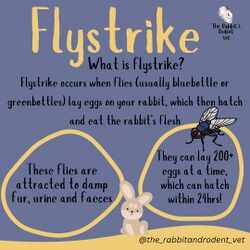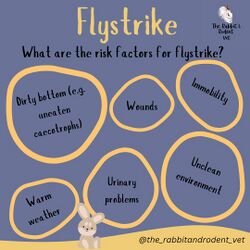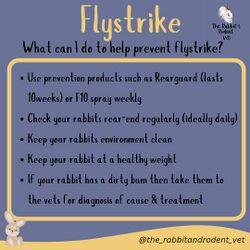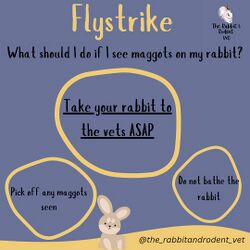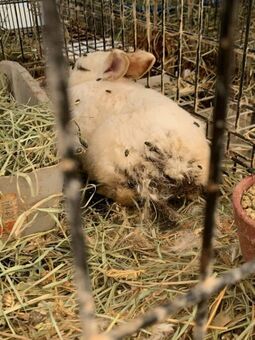Flystrike
Flystrike, also known as fly strike or myiasis, is a potentially fatal disease that is common in the warmer months of the year. It is caused by several types of insects that will lay eggs in the wounded skin of mammals, and the maggots hatching from the eggs then digest living tissue.
Species that cause flystrike in rabbits include the blowflies (the green bottle flies Lucilia sericata and the blue bottle flies Calliphora sp.), the grey flesh fly Wohlfahrtia sp., the common screwworm fly Callitroga sp., and from the botfly Cuterebra sp. (Western hemisphere only, also known as warble fly, wolf worm, and warbles). While not usual, the common house fly (Musca domestica) and other flies in the order Diptera can also cause flystrike when it lays eggs in matted fur coated in feces, and the hatched maggots rapidly move to an infected wound.[1]
Eggs are laid and hatch within 24 hours to L1 larvae which are non-pathogenic and cause no symptoms. The molt from L1 to L2 and L3 stages takes 3 days, during which tissue damage can be caused. Clinical signs become obvious at around 4 days post egg-laying.[2]
Myiasis cause by larvae of the Cuterebra flies is slightly different because their flystrike is not linked to poor hygiene. Instead of depositing eggs on skin soiled with urine or excrement, females deposit eggs near the entrance to a rabbit burrow or near an outdoor rabbit hutch.[3] Animals become infested when they pass through contaminated areas, and the eggs hatch in response to heat form a nearby host.[4]
Risk factors from a recently paper, from Great Britain, published in Preventive Veterinary Medicine.[5]
- Rabbits five years of age and over were more than 3.8 times likely to present for blowfly strike.
- Female entire rabbits were at greatest risk, being 3.3 times more likely to be affected than neutered females.
- For every 1 °C rise in predicted environmental temperature, there was a 33% increase in risk of flystrike.
Flystrike. The Rabbit & Rodent Vet
Flystrike by The Rabbit & Rodent Vet.[6] - "⚠️ Flystrike is a risk mainly to rabbits, but can also affect guinea pigs and other species." - The Rabbit & Rodent Vet
Symptoms
The most common site for flystrike in rabbits is the area at the base of the spine, between the tail and the back -- this is a difficult area for rabbits to groom effectively especially if they are overweight or have a flexibility problem.
Causes
- Matted fur - common in lionheads and Angoras.[2]
- Urine scald
- Dental disease - can cause ineffective grooming and allow mats to form.
- Uneaten cecals
- Damp and dirty bedding
- Warm temperatures and humidity of 60% or greater.[2]
- Skin fold dermatitis due to breed conformation or obesity.
- Abscessation from any cause.
Treatment and prevention
Initial treatment for flystrike involves clipping the fur and cleaning any affected areas. Then, the maggots are manually removed, and the wounds are flushed with a dilute chlorhexidine or povidone-iodine cleanser.[7] Fentanyl/fluanisone provides sedation and effective analgesia, and drying the area with a hair dryer can bring out any remaining maggots as they are attracted by the heat.[2]
Cuterebra larvae should be removed via their breathing hole either surgically or by using ivermectin.[7]
Supportive treatment should be aggressive with therapy for toxic shock and ivermectin or imidacloprid to kill any additional maggots or larvae that cannot be removed.[7]
The underlying cause of poopy butt should be addressed as well, and regular inspection of the rabbit's bottom and protection from exposure to flies is important to preventing flystrike.
Topical cyromazine (Rearguard, Novartis) applied as a 6% solution topically every 6 to 10 weeks can be used as a preventative for myiasis.[7]
Experiences
The following stories are cautionary tales about letting your rabbits live or explore outside.
- RVA Street Bunny Society. (2025). Abandoned bunny humanly euthanized due to severe and untreatable flystrike infestation. (Graphic) (RIP)
- u/Marsha_Cup. (2022). Video of a human medical doctor (MD) owner removing botflies from their rabbit (Graphic)
- Penny and Wild Smalls of South Florida. (2022). Bean's story (Graphic)
- Friends of Unwanted Rabbits. (2021). Butterscotch's story (Graphic)
- House Rabbit Resource Network. (2021). Mascha's story
- Rusty & Furriends: Vegas Dumpsite Bunnies. (2019). Carl's story (Graphic)
- Georgia House Rabbit Society. (2018). Odin's story (Graphic)
- Rabbit Rescue in Torun. (2018). Gardenia's story (Graphic)
- The Avian and Exotic Animal Clinic of Arizona. (2016). Video of botfly removed from a rabbit (Graphic)
- Robin Rysavy. (2015). The Dangers of Cuterebra in Rabbits (Graphic)
- Alan L. Moyer. (2014). Why We Won't Keep Rabbits Outdoors: A personal story
- World Wide Wounds. (2006). Veterinary care of a giant lop rabbit with severe fly strike (Graphic)
Further reading
- Marinell Harriman. (1993). Fly Strike
- Joy Gioia. (2015). Fly-Strike Emergency (Graphic)
- Sonya J. Miller-Smith. Flystrike in rabbits: the gruesome facts
- Rabbit Haven. Fly Strike
- Rabbit Welfare Association & Fund, Flystrike – don't get caught out.
- Rabbit Welfare Association & Fund, Flystrike – Is your rabbit at risk!
- Save a Fluff, Flystrike (myiasis) and how to prevent it
- Esther van Praag Ph.D. Myiasis (fly-strike) in Rabbits (Graphic)
- Esther van Praag Ph.D. Myiasis (botfly) in Rabbits (Graphic)
- Ontario Rabbit Education Organization. Bot Fly Infestation
- Daniel Calvo Carrasco. (2014). Prevention and Treatment of Fly Strike in Rabbits [PDF]
The following are some videos of botflies being removed:
- u/MarshaCup. (2022). Human doctor removing botflies that they thought were just abscesses. (Graphic)
- Hope Animal Hospital. (2015). Rabbit had 11 botflies removed. (Graphic)
- YouTube. (2018). Sweet Emily was abandoned and found in the trash with botflies. (Graphic)
Below are libraries with more links to information about flystrike.
- RabbitsOnline.net, LIBRARY: Rabbit Health > Fly strike
See also
References
- ↑ The Merck Manual for Pet Health. (n.d.). Flies and Mosquitoes of Horses. Retrieved 19 August 2015 from http://www.merckvetmanual.com/pethealth/horse_disorders_and_diseases/skin_disorders_of_horses/flies_and_mosquitoes_of_horses.html#v3221630
- ↑ 2.0 2.1 2.2 2.3 Varga, M. (2013). Textbook of rabbit medicine. (2nd ed.).
- ↑ MediRabbit.com, Esther van Praag Ph.D., Myiasis (botfly) in Rabbits
- ↑ Merck Veterinary Manual, Overview of Cuterebra Infestation in Small Animals
- ↑ Rachel Turner, Elena Arsevska, Beth Brant, David A. Singleton, Jenny Newman, PJ-M Noble, Philip H. Jones, Alan D. Radford, Risk factors for cutaneous myiasis (blowfly strike) in pet rabbits in Great Britain based on text-mining veterinary electronic health records. Preventive Veterinary Medicin, Volume 153, 1 May 2018, Pages 77–83.
- ↑ The Rabbit & Rodent Vet. (2025). Posted on Facebook March 23rd, 2025 from https://www.facebook.com/permalink.php?story_fbid=pfbid021wUvCsgwn2Ye8cTy9dZtSdFWm4PXfC6d6AKCrrbQ3HzpbPV55LZaYAXQDR9bpgt4l&id=61566923197386
- ↑ 7.0 7.1 7.2 7.3 Jepson, L. (2009). Exotic animal medicine: A quick reference guide. (1st ed.).



